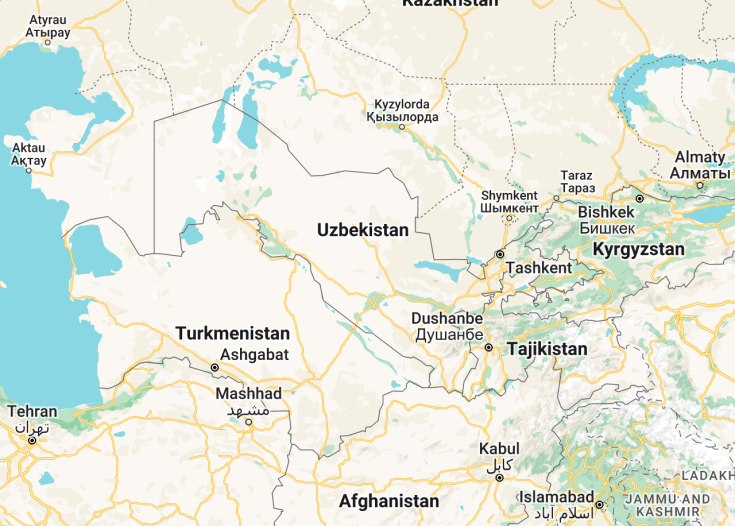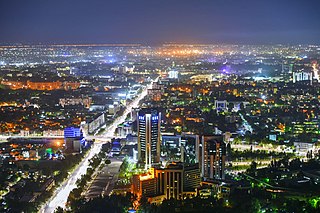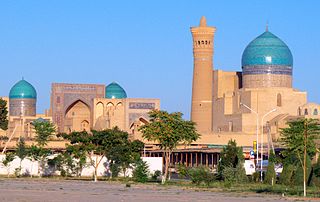Uzbekistan, a radiant gem of Central Asia, entices visitors with its illustrious history and breathtaking architectural marvels. As the cradle of the ancient Silk Road, it boasts cities like Samarkand, Bukhara, and Khiva, each echoing tales of conquerors and scholars from bygone eras. Majestic mosques, ornate madrasahs, and sprawling bazaars meld seamlessly with the vibrant landscapes, from the sultry Kyzylkum Desert to the verdant Fergana Valley. In Uzbekistan, every corner whispers legends of empires, while the warmth of its people ensures an unforgettable journey into the heart of Asia.
Engaging a local guide will illuminate the intricate stories behind the architectural wonders, enriching your exploration.
For an immersive experience, consider staying in boutique guesthouses, often refurbished historical homes, capturing the essence of Uzbekistan’s past.
Uzbekistan: The Heart of the Silk Road
| Capital | Tashkent |
| Time in Uzbekistan | GMT+5 |
| Language spoken | Uzbek |
| Population | 33.5 million (Source: World Bank 2022) |
| Religion | Islam (88%) Eastern Orthodox (9%) Other religions (3%) |
| Currency | Soʻm (UZS, лв) |
| Airports | Tashkent International Airport Samarkand International Airport Bukhara International Airport Namangan Airport |
Uzbekistan, a nation bathed in the golden hues of its sun-drenched cities and vast deserts, stands as a testament to the grandeur of ancient civilizations and the relentless march of history. Positioned at the crossroads of the legendary Silk Road, this Central Asian gem bore witness to a tumultuous confluence of cultures, empires, and epochs. From the valiant reigns of Tamerlane and the influential Timurid Renaissance to the blossoming of Islamic and Persian art and architecture, Uzbekistan’s history is as intricate as the patterns on its famed Ikat fabrics. Even today, its cities like Samarkand, Bukhara, and Khiva evoke a timeless aura, transporting visitors to a bygone era of caravanserais, madrasahs, and bustling bazaars.
Where is Uzbekistan located?
Uzbekistan is centrally located in Central Asia, sharing borders with five countries: Kazakhstan, Turkmenistan, Kyrgyzstan, Tajikistan, and Afghanistan.
What is Uzbekistan famous for?
Uzbekistan is famous for its stunning architecture, ancient cities, and the Silk Road. It is home to historical sites such as Samarkand, Bukhara, and Khiva, which showcase the country’s majestic Islamic and Persian influences. Uzbekistan is also renowned for its intricate hand-woven textiles, traditional music, and delicious cuisine.
History
Ancient Roots and Mausolean Period (circa 300 BC – 8th century AD)
The regions that constitute present-day Uzbekistan were historically part of the Mausolean Empire and later the Kushan Empire. With an advantageous geographical location at the crossroads of various ancient trade routes, including the Silk Road, cities like Samarkand and Bukhara began their long history as major centers of trade, culture, and learning. These ancient cities saw the confluence of multiple cultures, making the region a melting pot of diverse traditions.
Islamic Conquest and the Samanid Dynasty (8th century – 10th century)
The Arab invasion of the 8th century introduced Islam to the region, gradually becoming the dominant religion. The Samanid dynasty, which emerged in the 9th century, is credited for fostering an Islamic renaissance. Persian became the primary language of the elite, and Bukhara emerged as a center for Islamic scholarship and science.
Timurid Empire and Cultural Flourishing (14th century – 16th century)
In the late 14th century, the region witnessed the rise of Timur, commonly known in the west as Tamerlane. Establishing his empire, with Samarkand as its capital, Timur’s reign marked a period of architectural grandeur and cultural efflorescence. The following Timurid dynasty, especially under Ulugh Beg, made significant contributions to astronomy, arts, and mathematics.
Khanates Period (16th century – 19th century)
Post-Timurid era, the region fragmented into different Khanates, primarily Bukhara, Khiva, and Kokand. These Khanates often clashed but managed to foster a distinctive Central Asian culture. Their resistance to external invasions, especially from northern nomadic tribes, marked a significant part of their history.
Russian Conquest and Soviet Era (19th century – 1991)
The Great Game of the 19th century, a geopolitical struggle between the British Empire and the Russian Empire, saw Uzbekistan fall under Russian influence and later control. By the early 20th century, the entire region was integrated into the Russian Empire. Following the 1917 Russian Revolution, it became part of the Soviet Union as the Uzbek Soviet Socialist Republic. This period saw significant socio-political changes, including land reforms, forced collectivization, and a campaign against Islamic practices. Nonetheless, the era also brought industrialization, literacy, and urban development to Uzbekistan.
Independence and Modern Day (1991-Present)
Uzbekistan declared its independence from the Soviet Union in 1991. Islam Karimov, who led the country for over a quarter of a century, pursued policies that sought to define a unique Uzbek national identity while maintaining tight political control. Economic reforms, though at times hesitant, have sought to capitalize on the nation’s abundant natural resources, including gold and natural gas. Today, Uzbekistan, while navigating its post-Soviet identity, remains a significant player in Central Asia, balancing its rich historical legacy with aspirations of modernization and development.
Visit Uzbekistan
What to see and do in Uzbekistan
Uzbekistan offers a wealth of attractions that showcase its rich history and cultural heritage. Here are some must-see sights and activities:
- Explore the ancient city of Samarkand, with its stunning monuments like the Registan Square, Shah-i-Zinda complex, and Bibi-Khanym Mosque.
- Visit the historic city of Bukhara, known for its well-preserved old town and architectural marvels like the Ark Citadel and Kalyan Minaret.
- Discover the ancient ruins of Khiva, a UNESCO World Heritage site that transports visitors back in time.
- Experience the vibrant markets and bazaars of Tashkent, the capital city.
- Marvel at the natural beauty of the Chimgan Mountains and the Charvak Reservoir.
- Sample Uzbek cuisine, known for its flavorful pilaf, samsa, and shashlik.
- Immerse yourself in the traditional arts and crafts of Uzbekistan, such as miniature painting, carpet weaving, and ceramics.
Events in Uzbekistan
Uzbekistan hosts various events and festivals throughout the year, offering visitors a chance to experience the vibrant culture of the country. Some notable events include:
- Navruz (March): Celebrated to mark the arrival of spring, Navruz is a festive time with traditional music, dance performances, and the preparation of special dishes.
- Sharq Taronalari International Music Festival (August): Held in Samarkand, this festival brings together musicians and performers from different countries to showcase a wide range of musical traditions.
- Sabantuy (June): A traditional festival celebrating the end of the spring sowing season, Sabantuy features folk games, music, and horse racing.
- Silk and Spices Festival (May): Held in Bukhara, this festival celebrates the rich history of the Silk Road with colorful parades, traditional music, and performances.
Best time to visit Uzbekistan
The best time to visit Uzbekistan is during the spring (April to June) and autumn (September to October) seasons. The weather during these months is mild, and the landscapes are at their most beautiful. Additionally, major festivals such as Navruz and the Silk and Spices Festival take place during these periods, providing a unique cultural experience for visitors. It is advisable to avoid the extreme temperatures of summer and winter, as they can be uncomfortable for outdoor activities.
Is Uzbekistan worth visiting?
Uzbekistan is definitely worth visiting for those interested in exploring a country with a rich history, fascinating architecture, and vibrant cultural traditions. The ancient cities of Samarkand, Bukhara, and Khiva offer a glimpse into the country’s glorious past, with their stunning monuments and well-preserved old towns. The warmth and hospitality of the Uzbek people further enhances the travel experience. However, it is important to note that Uzbekistan may not be suitable for everyone. The country is still undergoing development in certain areas, and cultural differences and language barriers may pose challenges for some travelers. Nonetheless, for those who are willing to embrace these aspects and appreciate the unique charm of Uzbekistan, it is undoubtedly a destination that will leave a lasting impression.
Common Questions
What are the must-visit attractions in Uzbekistan?
What is the best time to visit Uzbekistan?
What are some traditional dishes to try in Uzbekistan?
- Plov: A flavorful rice dish cooked with meat, vegetables, and spices.
- Laghman: Hand-pulled noodles served with vegetables and meat.
- Shashlik: Grilled skewered meat, typically lamb or beef, seasoned with various spices.
- Samsa: Flaky pastries filled with meat or vegetables.
- Manti: Steamed dumplings filled with spiced meat or vegetables.
- Chuchvara: Small dumplings usually served in a clear broth.
These dishes are an integral part of Uzbek cuisine and represent the rich culinary heritage of the region.
What are the visa requirements for visiting Uzbekistan?
What are the popular traditional arts and crafts in Uzbekistan?
- Suzani embroidery: Intricate and colorful needlework, often used to decorate textiles such as wall hangings, pillows, or traditional clothing.
- Ikats: Traditional handwoven textiles with vibrant patterns, used for clothing, accessories, and home decor.
- Ceramics: Beautifully crafted pottery and ceramics, featuring traditional patterns and motifs.
- Wood carving: Skillfully carved wooden objects, including furniture, decorative items, and musical instruments.
- Miniature painting: Delicate and detailed paintings on paper or other surfaces, depicting historical or cultural scenes.
These traditional arts and crafts showcase the creativity and talent of Uzbek artisans.
What are the famous historical monuments in Uzbekistan?
- The Registan Square in Samarkand: A magnificent complex of three madrasahs, adorned with intricate tilework and architectural grandeur.
- The Ark of Bukhara: A massive fortress that served as the residence of the rulers of Bukhara.
- The Itchan Kala fortress in Khiva: A UNESCO World Heritage site with well-preserved ancient buildings.
- The Kalyan Minaret in Bukhara: A towering minaret that has stood for over 800 years.
- The Shah-i-Zinda necropolis in Samarkand: A stunning complex of mausoleums and tombs, known for its ornate tilework.
These historical monuments provide a glimpse into Uzbekistan’s rich history and architectural brilliance.
What outdoor activities can I enjoy in Uzbekistan?
- Trekking in the Tian Shan Mountains: Explore the rugged beauty of these mountains, with options for both beginner and experienced trekkers.
- Camelback riding in the Kyzylkum Desert: Experience the desert landscape on the back of a camel and enjoy the tranquility of the surroundings.
- Hiking in the Chatkal Mountains: Discover breathtaking landscapes, mountain lakes, and diverse flora and fauna while hiking through this mountain range.
- Boating on the Charvak Reservoir: Enjoy a relaxing boat ride on the picturesque reservoir, surrounded by mountains.
- Cycling in the Fergana Valley: Explore the scenic Fergana Valley on two wheels, passing through charming villages and beautiful countryside.
These outdoor activities allow you to connect with Uzbekistan’s natural beauty and experience adventure in the great outdoors.
What are the traditional festivals celebrated in Uzbekistan?
- Navruz: Celebrated on March 21st, Navruz marks the beginning of spring and is accompanied by colorful street festivals, performances, and traditional rituals.
- Kupkari: A traditional equestrian sport in which horse-mounted players compete to grab a goat carcass. This ancient game is held during the spring season.
- Sabantuy: A harvest festival celebrated in rural areas, featuring traditional games, horse racing, and wrestling competitions.
- Silk and Spice Festival: Held in Bukhara, this festival celebrates the region’s silk and spice trading history with vibrant cultural performances and exhibitions.
- Sharq Taronalari: An international music festival held in Samarkand, featuring performances from musicians and artists from around the world.
These festivals offer a wonderful opportunity to immerse yourself in Uzbekistan’s vibrant traditions and culture.
What are the traditional arts and crafts in Uzbekistan?
- Suzani embroidery: Intricate and colorful needlework used to decorate textiles such as wall hangings, scarves, or traditional garments.
- Ikats: Hand-dyed and handwoven fabrics with vibrant patterns, commonly used for clothing, accessories, and home decor.
- Ceramics: Beautifully crafted pottery and ceramics, often adorned with traditional patterns and motifs.
- Wood carving: Skillfully carved wooden objects, ranging from furniture and household items to musical instruments.
- Miniature painting: Delicate and detailed paintings on paper or other surfaces, depicting historical or cultural scenes.
These traditional arts and crafts form an integral part of Uzbekistan’s cultural identity and are treasured for their beauty and craftsmanship.
What are the popular souvenirs to buy in Uzbekistan?
- Suzani textiles: Exquisite embroidered textiles that can be used as wall hangings, pillow covers, or table runners.
- Ikat fabrics: Colorful handwoven fabrics with intricate patterns, perfect for clothing, accessories, or home decor.
- Ceramics: Beautifully crafted pottery and ceramics, including plates, bowls, and decorative tiles.
- Wooden crafts: Hand-carved wooden objects such as boxes, ornaments, and utensils.
- Traditional musical instruments: Instruments like the dutar or doira, which are used in traditional Uzbek music.
- Turkmen rugs: Traditional rugs known for their vibrant colors and intricate patterns.
These souvenirs offer a taste of Uzbekistan’s culture and craftsmanship and make for memorable gifts or keepsakes.














